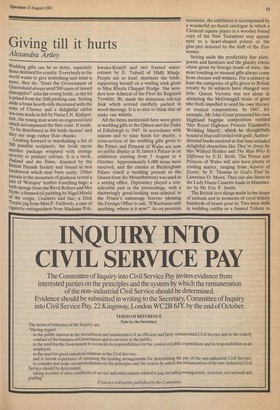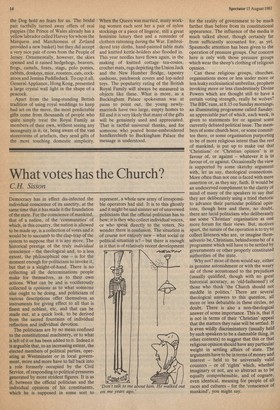Giving till it hurts
Alexandra Artley
Wedding gifts can be so dotty, especially those destined for royalty. Everybody in the world wants to give something and what is more, they do. 'Does the Government of Queensland always send 500 cases of tinned Pineapples?' asks the young bride, as the lid IS prised from the 26th packing case. Setting aside a brass hearth-tidy decorated with the arms of Chester and a delightful rabbit tea-cosy made in felt by Nurse I.N. Kirkpatrick, the young man scans an engraved card Which accompanied the first crate. It reads, To be distributed as the bride desires' and they are rings rather than chunks. Looking forward to marshalling a list of 500 possible recipients, the bride opens another package wrapped with strange severity in primary colours. It is a book, Finland and the Finns, donated by the British Finnish Society and bound in real birchwood which may burn easily. Other parcels in the mountain of gladness reveal a Pair of `Watajoy' leather travelling bags; a bath sponge from the Revd Robert and Mrs Hyde; a framed oil painting by Nigel Mould of the corgis, Crackers and Sue; a Dick Turpin jug from Miss P. Fullforth; a case of cigarette extinguishers from Madame Pok lewaka-Koziell and two framed watercolours by E. Tufnell of HMS Whelp. People are so kind, murmurs the bride, supporting herself on a wading stick given to Miss Rhoda Chappel Hodge. She wonders how Admiral of the Fleet Sir Reginald Tyrwhitt, Bt, made the miniature roll-top desk which arrived carefully packed in wood-shavings. It is so nice to think that all ranks can whittle.
All the items mentioned here were given as wedding gifts to the Queen and the Duke of Edinburgh in 1947. In accordance with custom and to raise funds for charity, a cross-section of the wedding gifts given to the Prince and Princess of Wales are now on public display at St James's Palace in an exhibition running from 5 August to 4 October. Approximately 6,000 items were received, and the cinema at Buckingham Palace (itself a wedding present to the Queen from the Mountbattens) was used as a sorting office. Diplomacy played a considerable part in the proceedings, with a shatteringly good-looking rear-admiral in the Prince's entourage forever phoning the Foreign Office to ask, 'If Ruritania sent anything, where is it now?' As on previous occasions, the exhibition is accompanied by a wonderful po-faced catalogue in which a Clementi square piano or a wooden bound copy of the New Testament may appear next to a heart-shaped potato or the glue-pen donated by the staff of the Economist.
Setting aside the predictably fine plate, jewels and furniture and the ghastly ethnic objets given by foreign heads of state, the most touching or unusual gifts always come from obscure well-wishers. For a century at least the categories of gifts given to British royalty by its subjects have changed very little. Queen Victoria was not alone in attracting the McGonagall strain of giver who feels impelled to send his own literary or musical compositions. In 1947, for example, Mr John Grant presented his own Highland bagpipe composition entitled 'Her Royal Highness Princess Elizabeth's Wedding March', which he thoughtfully bound in blue calf tooled with gold. Authordonated books received at that time included delightful obscurities like They're Away by Mrs Wilfred Holden and The Man Who Is Different by E.D. Hebb. The Prince and Princess of Wales will also have plenty of reading matter, ranging from Aspects of Exeter, by P. Thomas to God's Fool by Lawrence D. Moon. They can also listen to the Lady Diana Cassette made in Manchester by Mr Eric P. Smith.
The British love things made in the shape of animals and in moments of royal felicity hundreds of beasts pour in. Two mice dolls in wedding outfits or a framed Tribute to the Dog hold no fears for us. The bridal pair tactfully turned away offers of real puppies (the Prince of Wales already has a yellow labrador called Harvey for whom the Marquess and Marchioness of Zetland provided a new basket) but they did accept a very nice pair of cows from the People of Jersey. Ornamentally, however, the skies opened and it rained hedgehogs, beavers, frogs, camels, foxes, stags, polo ponies, rabbits, donkeys, mice, roosters, cats, cockatoos and Jemina Puddleduck. To cap it all, General Appliance, Hong Kong, presented a large crystal wall light in the shape of a peacock.
Apart from the long-standing British tradition of using royal weddings to keep bad art on the move, the most predictable gifts come from thousands of people who quite simply treat the Royal Family as members of their own, without seeing any incongruity in it, or, being aware of the vast storerooms of artefacts, they send gifts of the most touching domestic simplicity. When the Queen was married, many working women each sent her a pair of nylon stockings or a piece of lingerie, still a great feminine luxury then and a reminder of clothers rationing during the War. Embroidered tray cloths, hand-painted table mats and knitted kettle-holders also flooded in. This year needles have flown again, in the making of knitted cottage tea-cosies, crochet mats, rugs depicting the Union Jack and the New Humber Bridge, tapestry cushions, patchwork covers and lop-sided toys. The popularity rating of the British Royal Family will always be measured in objects like these. What is more, as a Buckingham Palace spokesman was at pains to point out, the young newlymarrieds have two large, empty homes to fill and it is very likely that many of the gifts will be genuinely used and appreciated. That is tactful universal thanks, and for someone who posted home-embroidered handkerchiefs to Buckingham Palace the message is understood.



































 Previous page
Previous page